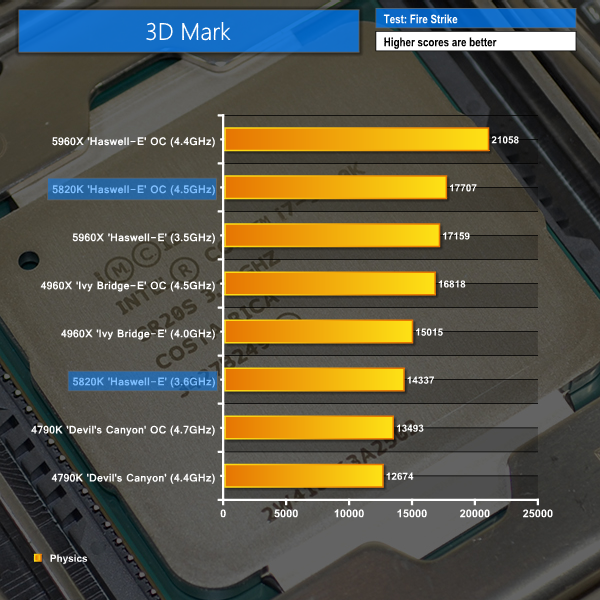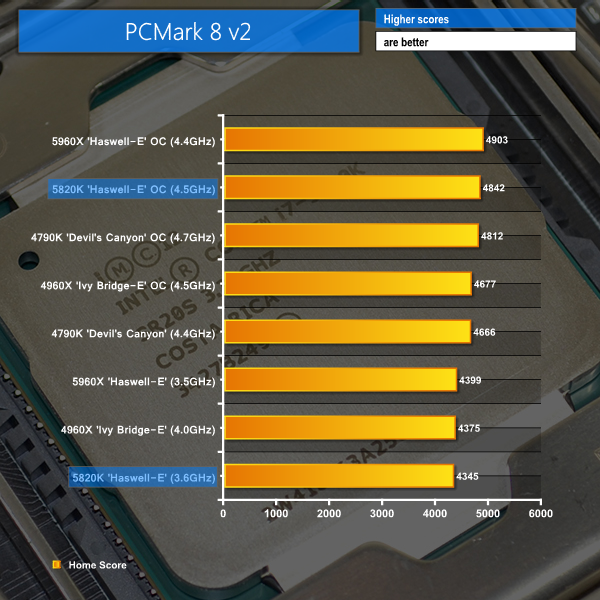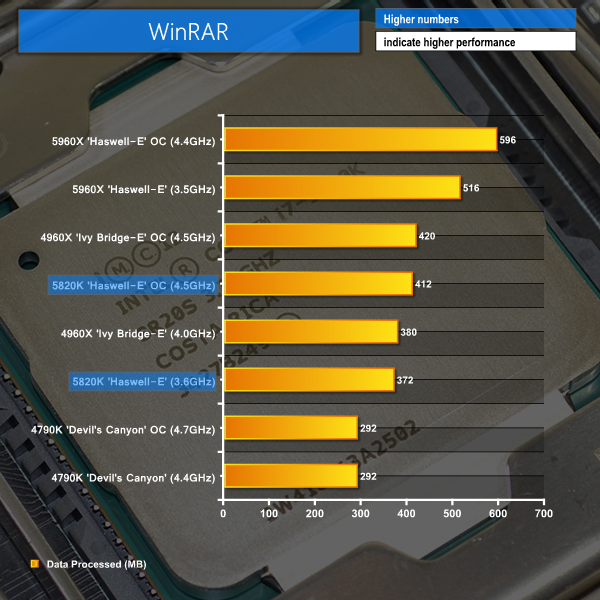3DMark
We used 3DMark‘s ‘Fire Strike’ benchmark which is designed to be used on gaming PCs. We opted for the Normal setting, NOT the Extreme mode.
PCMark 8 v2
We used the ‘Home’ test in PCMark 8 v2 to analyse the general-usage performance of each processor configuration.
WinRAR
WinRAR’s built in benchmark and hardware test can help us outline the performance differentials between each processor configuration. We record the amount of data processed after a 30-second run.
The Physics test in 3DMark shows a balanced fondness for cores, cache, and clocks. Micro-architectural advantages also weigh in on the scoring metric. Devil's Canyon's high operating frequency keeps it to within 2000 points of the stock-clocked Haswell-E hexa-core.
When both chips are overclocked, the 5820K pulls away from the Devil's Canyon part, opening up a 31% performance advantage over the quad-core.
PCMark 8 v2 seems heavily weighted towards processor frequency, with core count also showing some influence in the scoring. Devil's Canyon's high clock speeds, even at stock parameters, garner it solid results in the test. It takes a sizeable frequency boost for the 5820K to turn its 321-point stock vs stock deficit, against the 4790K, into a 30-point OC vs OC lead.
That said, other factors, such as SSD speed and memory performance, are also weighted in the PCMark 8 v2 scoring procedure, so these results should be interpreted with care.
Cores are the biggest deciding factor for WinRAR‘s archival performance. The reference-clocked, twelve-thread 5820K stamps its authority with a 27% performance advantage over the stock 4790K. Overclocking the Haswell-E hexa-core extends that lead to 41%.
That number is a little superficial due to WinRAR's inability to take advantage of 300MHz added onto the 4790K's already high clock speed (in our batch of repeated testing, at least). Lower memory latencies edge the 4960X in front of the 5820K when both chips are overclocked.
 KitGuru KitGuru.net – Tech News | Hardware News | Hardware Reviews | IOS | Mobile | Gaming | Graphics Cards
KitGuru KitGuru.net – Tech News | Hardware News | Hardware Reviews | IOS | Mobile | Gaming | Graphics Cards






MKV is not a video format, it is a container. What format was the video in for the conversion? Odds are it was already an MP4 encoded using H.264 which was Stored as a stream inside the MKV file – meaning your test was just resampling the original file and not really encoding anything.
You are correct. As suggested, the file uses an MPEG-4 part 10 (H.264) codec and is simply contained within the MKV container. The operation being run is more of a remuxing process than an encode – it takes the H.264 video out of a MKV container and puts it into a MP4 container.
The test results are still perfectly valid and highlight differences in processing power. I will look into a ‘true’ encode test for future usage.
Well, a couple things about video encoding you should probably take into account. 1) Your using Handbreak, which uses Gstreamer, which doesn’t natively use Intel’s Quick Sync Video – but it does Use VCE (the Radeon 280x in your test build supports VCE) 2) so while you where testing the processors ability to pass information along, you won’t actually be testing the SIP components on the Processors unless you use a program that fully utilizes the Gen2 and Gen3 Intel Quick Sync technologies in the IB-E or the Haswell.
So unless you use a program that isn’t routing directly through the video card, you won’t actually be testing the processor with video encoding.
But the issue is that QuickSync doesn’t exist on the platform LGA2011, that is part of the platform 1155/1150 as they have their GPU builtin on the die, unlike the LGA2011 counterparts.
One of the processors being compared here (the 4790k) has Intel Quick Sync. just because the 5820k doesn’t, doesn’t mean the tests used shouldn’t support it. I was also bringing up the fact that any transcoding done on this specific build will utilize the GPU’s video encoding technology and not really be a true representation of the CPU’s encoding ability.
Could somebody help me pls?
I have a sabertooth z97 mark 1 and it is supposed to run 5th gen processor (updating it), but the thing is that the socket the mother has is an 1150 and I see the 5th gen are lga 2011 or 2011-v3. Here comes my question.
After my BIOS is upgraded it’s supposed to work with the lga 2011 processors?
my i7 5820k at stock speeds idles at around 29 degrees celcius with an h100i and all case fans at max. is that ok???
That’s typical, provided the ambient temperature is in the low 20s. Mine’s currently at 4.5ghz idles around 33c with a custom loop
Denise, I imagine you’ve gotten the answer to this question by now, but the 1150 and the 2011 sockets are unfortunately physically different so a BIOS update will not let you use any of the Haswell-E CPU’s in the 1150 socket.